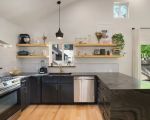How to Remodel a Kitchen with Limited Space: Expert Tips
Apr 17, 2025
Remodeling a Kitchen with Limited Space: How I Transformed My Small Kitchen
As someone who loves cooking but has a kitchen that’s far from spacious, I can tell you that remodeling a kitchen in a small space is both a challenge and an opportunity. I’ve spent a lot of time figuring out how to make the most of limited space, and while it wasn’t easy, the results were absolutely worth the effort. Over the years, I’ve discovered a range of design tricks and creative solutions to transform a cramped kitchen into a functional, stylish space.
I remember feeling frustrated with my kitchen—there wasn’t enough counter space, storage was always a problem, and it felt like I could never have more than one person working in there at a time. But with the right planning, the right materials, and a little creativity, I turned my tiny kitchen into a space that works perfectly for my needs. If you’re facing a similar dilemma, here are some practical tips and tricks I learned that will help you remodel your kitchen with limited space.
1. Plan with Purpose: Maximizing Space and Functionality
When I first started thinking about remodeling my small kitchen, I quickly realized that planning was the most important step. The goal isn’t just to make the space look better—it’s about improving its functionality so you can actually use it effectively. I spent a lot of time considering how I used my kitchen and what could make my life easier.
For example, one of the first things I did was identify my top priorities. Did I need more counter space for meal prep? Did I need additional storage? Or was it more important for me to have better lighting or a more open feel to the space? This thought process was crucial, as it helped me focus on the areas that truly mattered, rather than trying to fit in everything I wanted.
Once I had my priorities straight, I started thinking about how to make the most of the limited space. I learned that using every inch of available space is key in a small kitchen. For example, I used the area above the cabinets for storage, added pull-out drawers to cabinets, and incorporated vertical shelving. These small changes made a huge difference in how efficiently the space functioned.
2. Choose Compact and Multi-Functional Appliances
One of the most significant challenges of remodeling a small kitchen is dealing with limited space for appliances. When I began the remodel, I realized that the bulky appliances I had were taking up too much valuable space. I wanted to keep the kitchen functional without making it feel overcrowded.
My first step was to choose smaller, compact appliances that still offered the features I needed. For example, I replaced my standard fridge with a more compact model that was perfect for my space but still offered plenty of storage for fresh food. Similarly, I swapped my regular oven for a smaller, more efficient wall-mounted oven and combined it with a microwave oven for added flexibility.
Another thing I learned was the importance of multi-functional appliances. If you’re short on space, every appliance should serve more than one purpose. I replaced a bulky coffee maker with a small appliance that worked as both a coffee machine and an espresso maker, saving me counter space. I also considered getting a combination washer/dryer unit to eliminate the need for separate appliances.
3. Use Creative Storage Solutions
Storage is always a challenge in small kitchens, but there are many creative ways to store your kitchen essentials without sacrificing valuable space. When I remodeled my kitchen, I made sure to include storage solutions that were practical yet stylish.
For example, I added under-cabinet storage by installing pull-out racks for spices and cleaning supplies. This not only saved me space but also helped me keep everything organized and easily accessible. I also incorporated drawer dividers for utensils and kitchen tools, ensuring that everything had its own designated spot and reducing clutter.
Open shelving was another great solution for my small kitchen. I used it to store items I frequently needed but didn’t mind displaying, like my favorite mugs, bowls, and plates. This created a sense of openness and made the kitchen feel less cramped while also providing easy access to the things I use daily.
4. Opt for Light Colors to Create the Illusion of Space
One of the tricks I learned when remodeling a small kitchen is how much of a difference color can make. Dark colors can make a space feel smaller and more enclosed, while lighter colors help open up a room and make it feel more spacious. Since my kitchen was small, I decided to go with light colors for the walls, cabinets, and countertops to create the illusion of more space.
I chose a light, neutral color palette with shades of white, off-white, and pale gray for the cabinetry and walls. This made the kitchen feel brighter and more open. I also used a lighter color for the flooring to tie the look together. When it came to the backsplash, I opted for a subway tile design in white, which was timeless and simple but still added some texture and interest to the space.
If you’re working with limited space, choosing the right colors for your kitchen can make a world of difference in how large or small the room feels. Lighter shades reflect more light, making the space feel airy and open, which is essential for a small kitchen remodel.
5. Open Up the Layout with Smart Design Choices
When dealing with limited space, the layout of the kitchen is crucial to ensuring that it functions efficiently. I learned that opening up the space as much as possible was key to making my kitchen feel more spacious.
For my remodel, I opted for an open-concept design by removing a wall that separated the kitchen from the dining area. This created a more fluid transition between the two spaces and made the kitchen feel much larger. If you’re not able to make structural changes like this, there are still ways to optimize your layout.
For example, consider installing an island or a breakfast bar that serves as both additional counter space and a place to eat. Even a small island with storage underneath can make a big difference in maximizing the functionality of a small kitchen. In my case, I went for a narrow island with built-in shelves to store pots and pans, freeing up space in my cabinets.
6. Lighting: Brightening Up a Small Space
Lighting is another essential element that can make a small kitchen feel larger and more welcoming. I learned that good lighting not only improves visibility but also creates a sense of space and openness. In my kitchen remodel, I focused on maximizing natural light by adding larger windows and using sheer window treatments to let in as much light as possible.
For the artificial lighting, I installed under-cabinet lighting to illuminate the countertops and provide task lighting for meal prep. I also added recessed lighting in the ceiling to brighten up the entire space. These light sources helped make the kitchen feel less cramped and more inviting.
Additionally, I used pendant lights over my island to add a touch of style while also providing focused lighting for cooking and eating. These small design changes made a huge impact on the ambiance of the kitchen.
7. Personalize the Space with Style
While functionality is the priority in a small kitchen, it’s also important to make the space feel like your own. I added personal touches to my kitchen remodel by incorporating elements that reflected my style. For example, I used decorative storage containers, a colorful rug, and some unique artwork on the walls.
One of the best decisions I made was to add open shelving with a few well-chosen decorative items. Whether it was a set of vintage mugs or a beautiful fruit bowl, these personal touches gave my kitchen warmth and character without taking up extra space.
Even in a small kitchen, you can personalize the space by choosing the right accessories and adding a few items that make you feel at home.







